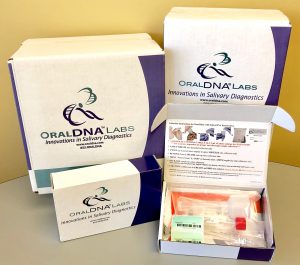
According to an article written in the Journal of Clinical Microbiology, January 2009, “Saliva is a representative diagnostic specimen for an overall view of the oral microbiota, since bacteria from various sites and surfaces of the oral cavity are found in saliva and mouth rinses.”1 The OralDNA® salivary diagnostic collection is based on this principle, among several others, supporting saliva as a testing medium. Over the past decades, cumulative research has been instrumental in elevating salivary diagnostic testing in a dominant serum-testing world.
In the dental field, taking a saliva sample seems second nature versus drawing a blood sample. Our clinicians would need additional skillsets for serum collection. And really, would this give us the information we needed? What about the patients comfort? Some patients already have a phobia of the dentist, add in the fact there may be a blood draw and we may scare these patients away completely. A simple, non-invasive swish and gargle makes sense to both dental clinicians and patients alike.
At OralDNA® Labs, the collection method for every test on the menu is the same, (aka: Universal Collection Technique) simply ask the patient to perform a vigorous 30 second swish and gargle with the provided sterile saline, and expectorate into the provided funneled collection tube. This allows us to capture prevalent DNA information ranging from periodontal pathogens, genetic DNA, to viral DNA. After the preservative is added, stabilizing the specimen for 21 days, the sample collection is complete! (View Collection Instructions HERE)
The analytical minds of many dental professionals may be thinking, “How does a simple swish and gargle with sterile saline capture what is needed for a periodontal bacterial analysis?” The science behind securing a bacterial specimen via the saline is simple; gingival crevicular fluid (GCF) is an exudate, a clear exudate that gets expressed into the oral cavity once every 90 seconds. The GCF is free floating in the oral cavity and the swish and gargle captures it perfectly.
MyPerioPath® finds hidden oral pathogens that threaten oral and systemic health. We have developed guidelines called MyPerioPath® Collection Recommendations (Found HERE) to help ensure the bacterial collection is optimal. Just as a medical doctor may ask a patient to fast for 12 hours prior to a blood draw; please consider these recommendations when collecting a saliva sample for MyPerioPath® testing. (Note these are recommendations, not requirements.) For instance, if your patient just brushed their teeth, we recommend a wait time of 30 minutes before collecting a specimen for a MyPerioPath® testing. Another guideline is to collect a specimen for the MyPerioPath® testing before any major biofilm disruption. This means if you have already completed a cleaning or started periodontal therapy, then it is recommended that the patient be rescheduled in 2 weeks time for specimen collection.
When I graduated in 2000 I never imagined where dentistry would be today, and I am excited where it may go in the future. The information we can now secure to better understand and treat our patients is changing. By knowing and applying this information, we elevate ourselves from dental professionals to oral health care professionals! And just to think, a simple 30-second swish and gargle can get us there!
- J. Clin. Microbiol. January 2009 vol. 47 no. 1 235-238
For more information on how to become an OralDNA Provider – scan HERE: 
- Practicing Dental Medicine: The Partnership with a Clinical Laboratory - December 13, 2024
- Olympic Spirit: Achieving Gold in Healthcare - August 16, 2024
- The Winning Team: The Healthcare Provider & The Clinical Laboratory - April 12, 2024
